The Hunt for Damage: Where are our most damage-susceptible areas when it comes to wind and hail damage to commercial buildings?
By Amber Prom, P.E., Director of Curriculum, Forensic Engineer
When assessing a property for potential hail and/or wind damage, evaluating is easier when we understand how storms impact a building. If you’ve taken any of Haag’s damage assessment training, you know by now that storms typically impact a property with directionality. Winds are blowing a certain direction, the storm itself is moving in a certain direction, and thus, the winds are going to push on some of the building surfaces and pull on other surfaces depending on which direction the winds are blowing. In the same sense, hailstones are going to fall from the sky in a diagonal nature, causing more direct and frequent impacts on some structure surfaces, with little to no impacts on others. Moreover, there are certain areas of a building that are simply more susceptible to becoming damaged by winds or hailstone impact than others. By utilizing this knowledge, we can predict which portions of a building are likely to be more severely impacted by a storm, and where the weak spots are in a building, and look first at wherever those two areas overlap as these areas would surely become damaged before any other portions of the building.
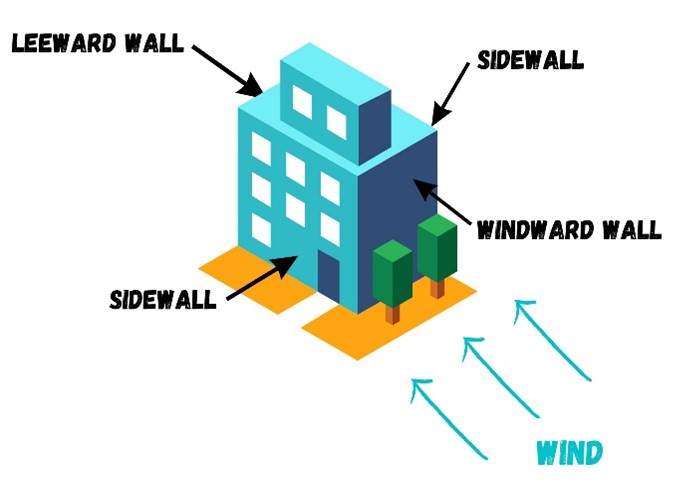
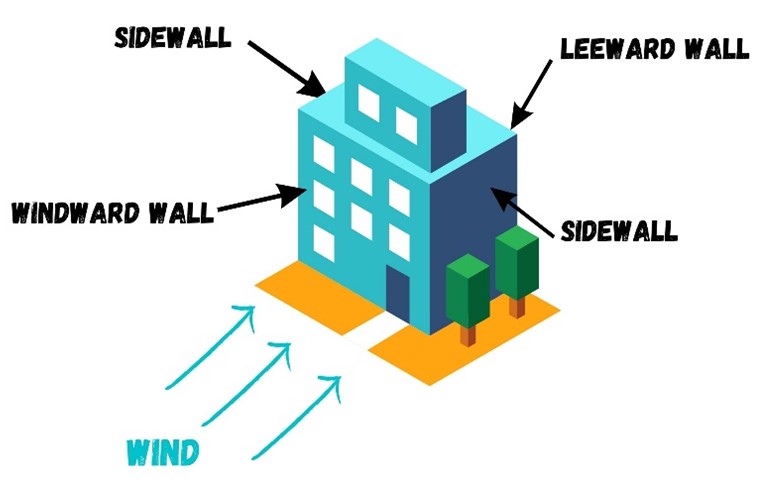
High wind pressure zones
As mentioned previously, the winds in any given storm (except hurricanes) are, in most cases, going to blow in one primary direction. That direction can change from storm to storm, but for any given storm, a single property typically experiences winds blowing in one primary direction. Based on this direction, we can label the surfaces of our structure and predict what type of damage might occur from the resulting wind pressures.
As far as terminology goes, any wall or roof surface that is facing the direction of the wind is going to be termed ‘windward’. This would include any wall surfaces and any roof facets that are perpendicular to and facing the directionality of the wind. Any wall or roof facet that is facing perpendicular to but away from the directionality of the wind is going to be termed ‘leeward’. These would be the walls opposite the windward walls. And any surfaces that are parallel to the wind directionality are typically termed ‘sidewalls’, as shown above in Figures 1 and 2.
Based on this philosophy, pushing wind pressures are going to be applied to the windward elevations of the structure, and a pulling or suction pressure is going to be applied to all the other surfaces that the wind is speeding past. That includes the sidewalls, the leeward wall, as well as the majority of the roof surface. Moreover, an increased wind pressure is going to be applied anywhere the wind must change speed and direction. So, this is going to be all around the perimeter edges of a structure’s walls and roof. As soon as the wind has to navigate around an obstacle in its way, such as a building, it is forced to change direction and increase its speed, which causes it to pull on the structure with even more force. Because of this, we get varying wind pressures across the building envelope with some pushing and some pulling, in varying degrees. This is demonstrated in Figures 3-5.

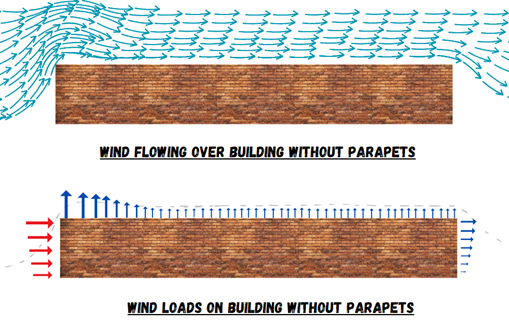

So, as we can see, we have a pushing force on the windward wall, which means we are going to have our highest chance of damage from windborne debris impact on this elevation. We are also going to have our highest chance of windows and doors blowing inward on these elevations as well. We will not, however, have a higher chance of our siding being pulled off of this elevation as the winds are pushing inward, not pulling outward.
On the sidewalls, we have our highest chance of the siding being pulled off near the corners of the building, especially those corners near the windward wall.
On the leeward wall we also have the highest suction pressures along the corners of the building and along the top edge of the wall, essentially all around the perimeter of this wall is where we would expect to lose portions of the building envelope.
And on the roof, we have our highest pressures along the windward edge of the roof as that wind has to navigate up and over the structure at this location. These high wind pressure zones are demonstrated in Figure 6 for all wind directionalities combined and as you can see, because of the overlap in the increased perimeter wind pressures, the corners of the roof and walls experience the highest wind pressures of all.

So, with all that said, when it comes to direct wind damage to the building envelope, we would expect for the damage to occur where the building is experiencing the highest wind pressures, assuming that all siding is attached the same and all roofing is attached the same. This means, in general, we should experience wind damage first near the building corners, then near the perimeter edges of the walls and roof, and then in the middle of the walls and roof. And when it comes to indirect wind damage to the building, i.e. impact from windborne debris, we would expect this to occur on the windward elevation of the structure.
Areas most exposed and susceptible to hail damage
Just like wind, hailstones impact a structure with directionality. And because of this, the windward-facing elevations of the building, any windward-facing roof facets, and the windward elevations of any signage, parapet walls, and mechanical units will receive more impacts from falling hailstones. As can be seen in Figures 7 and 8, depending on the directionality of the storm, the windward elevations will be impacted more severely by the hailstones and the leeward-facing elevations are quite shielded from impact. Portions of the roof are shielded from impact by things like the windward parapet wall and large mechanical units, while the roofing that covers the windward side of the mechanical unit curbs and the interior of the leeward parapet wall are most susceptible to incurring direct hits from the falling hailstones. So, knowing this, we can determine the directionality of the storm and predict which areas of the building envelope should be receiving little to no damage from hailstone impact, and which portions would be most exposed.
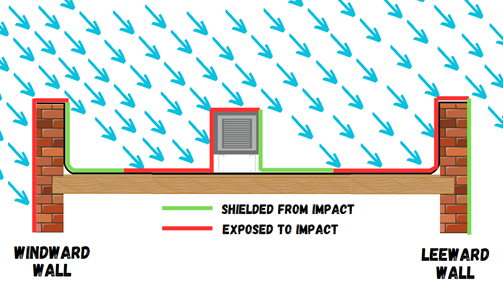
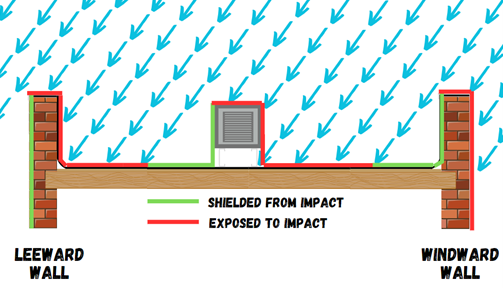
Taking this a step further, there are portions of every low-sloped roof that are more susceptible to becoming damaged by hailstone impact than others and these would be, among others, any portions of the roofing that do not have good, solid substrate support. This can happen if the roof is blistered or wrinkled in any way, at steps in the roof, and on almost every commercial roof this occurs along the perimeter of mechanical unit curbs and all around the perimeter parapet walls where the roofing must make a transition from a horizontal surface to a vertical surface. At these areas, the roofing membrane has little to no substrate support, as can be seen in Figures 9-12.
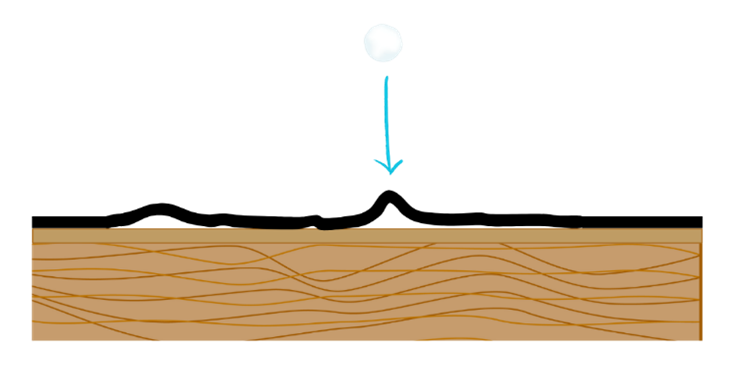
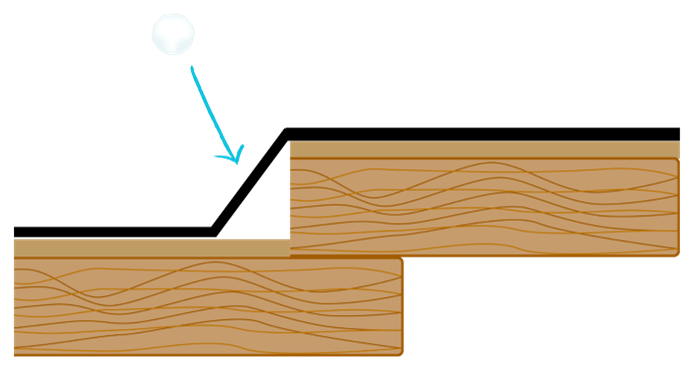
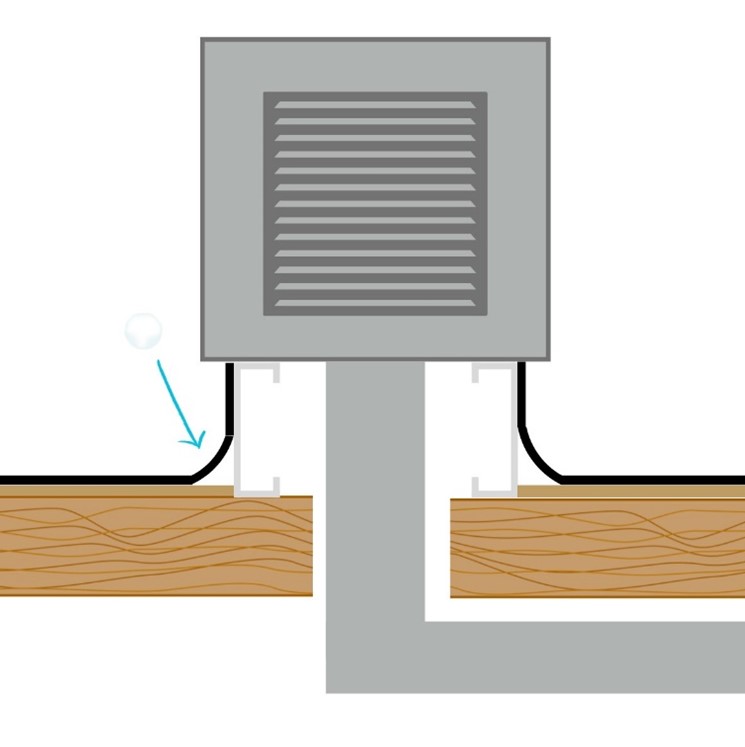
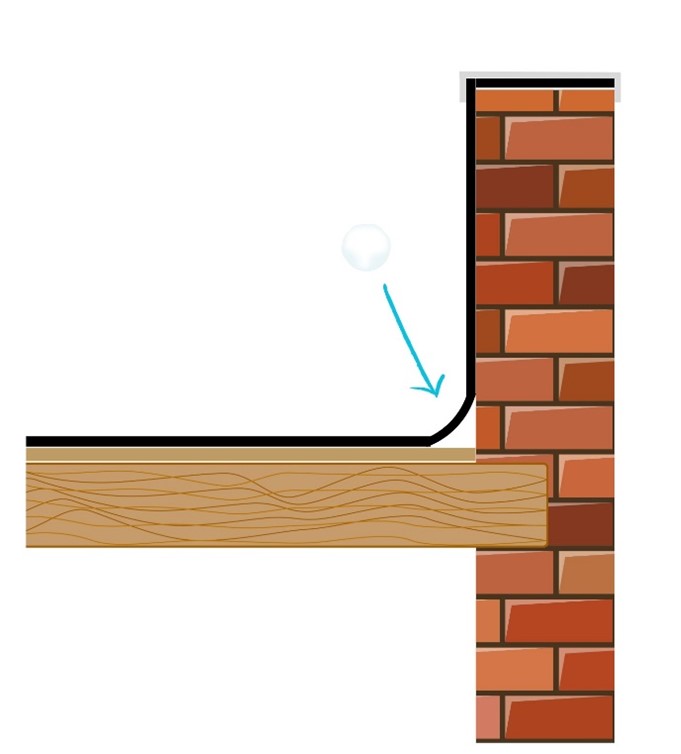
Each one of these locations creates a condition where the roofing has little to no support behind it, making it easier to puncture than the remainder of the roofing. So, if we put all of this together, we can see that the fist places one should look for hail damage on a commercial roof are any location where the roofing might lack substrate support and that would be exposed to direct impacts from falling hailstones based on the directionality of the storm. It is these locations that would surely become damaged first and foremost on any commercial roof that’s been exposed to sizeable hailstone impacts.
Now with all this said, this does not mean that wind damage cannot happen in areas of the roof outside the highest wind zones. In fact, some roofing systems are designed to have more robust fastening in the high wind zones of the roof and thus, may not be the first areas to fail. In addition, there could be areas of the roof located in the lower wind zones that have an underlying condition, like an installation deficiency or advanced deterioration, which would cause them to not be able to resist wind uplift pressures as well as the surrounding areas. And thus, it is not a hard and fast rule that wind damage must occur in the high wind zones, but rather, it is a logical tool that we can use that applies most of the time. This also goes for hail damage as there could be other areas of the roof that have poor substrate support than those discussed here. There could also be conditions on the roof that would make other areas more susceptible to becoming damaged, like areas that experience frequent ponding of water, or areas near gas pipes and mechanical units that may be exposed to heat, grease, or vapors. So again, this is a general rule of thumb and not a hard and fast rule. But regardless, utilizing what we know about storms and these commercial roofing systems can help us identify those areas that are most likely to become damaged by mother nature.
If you’d like to learn more about the damage assessment of commercial roofing, Haag now offers Hail & Wind Damage to Commercial Roofing, a 6-hour on-demand comprehensive course that begins with a refresher on weather basics, including both wind and hail. It then moves on to low-slope/commercial roofing systems in general. And finally, it moves into a separate section for each of the most common commercial roofing materials encountered on site today.
The roofing types covered in this course include:
- Built-Up Roofing
- Modified Bitumen Roofing
- Single Ply Roofing (TPO/PVC/EPDM)
- Spray Polyurethane Foam (SPF) Roofing
- Metal Roofing
And each of these individual sections cover the following topics for each roofing material type:
- The manufacturing process
- Installation & fastening requirements & processes
- Weathering & anomalies encountered in the field
- Hail damage assessment
- Wind damage assessment
- Repair protocol
This course is recommended for anyone trying to advance their career into commercial inspections, anyone who is just starting to assess commercial roofs, or anyone that would like to learn more about commercial roofing but is not interested in a certification in commercial roofing inspections.
If you are someone who has experience in commercial roofing damage assessment but wants to elevate your game/knowledge further, our Haag Certified Inspector- Commercial Roofing course is your best bet. This course covers the same material but in further depth, earning you the Haag Certified Inspector- Commercial Roofing badge. This course requires that the student has performed at least 50 commercial roof inspections, so it is not for beginners, but rather those with a bit of commercial roofing assessment experience.
Author

Amber Prom, P.E., Director of curriculum
Amber M. Prom, P.E., is Haag’s Director of Curriculum and is based out of the greater Denver area. Ms. Prom is a Registered Professional Civil/Structural Engineer with approximately 20 years’ experience in structural design, project management, forensic engineering, and engineering management/training. Ms. Prom previously worked in the field of forensics as a Professional Development Manager and Principal Consultant for approximately 10 years. As a Professional Development Manager, she was responsible for training all newly hired Civil/Structural Engineers and Building Consultants and providing continuing education/training for existing experts. As a Project Engineer/Principal Consultant, she conducted forensic engineering investigations related to structures which had failed, become damaged, did not operate/function as intended, or were constructed deficiently. Most of her investigations involved hail damage to structures caused by wind, hail, tornados, hurricanes, and earthquakes, along with fires, explosions, ground vibrations, and construction defects. Ms. Prom has also been engaged as an expert witness in numerous mediations, arbitrations, depositions, and trials throughout her career. Currently, Ms. Prom acts as Haag’s Director of Curriculum and develops/manages all of Haag Education’s training curriculum, including the Haag Certified Inspector and Haag Certified Reviewer Programs.
Any opinions expressed herein are those of the author(s) and do not necessarily reflect those of Haag Technical Services, Haag Engineering Co., Haag Education, or parent company, Haag Global, Inc.

